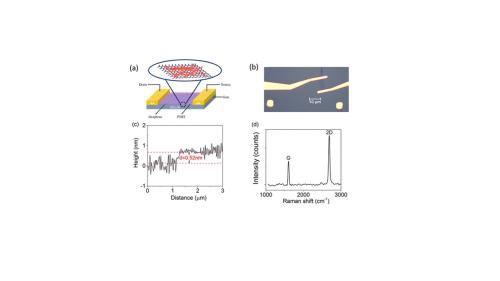Technologies Available for License
Categories: advanced materialsenergy
2018-008: Hybrid Graphene-Conductive Polymer Photodetectors
Invention: 2018-008
Patent Status: U.S. Patent Number 109,716,352 was issued on April 6, 2021
For technical and licensing related questions, email tcp@bnl.gov.
Summary

Figure: (a) Cartoon of the SLG–P3HT nanowire hybrid FET showing the nanowire mesh (red color) responsible for light scattering and increased light absorption in the polymer, leading to increase hybrid FET photoresponsivity. (b) Optical reflection image of a pristine graphene FET. (c) Graphene thickness estimated by AFM. (d) Raman microspectroscopy of exfoliated graphene on the Si/SiO2 substrate.
Graphene is a zero bandgap semiconductor with excellent electron mobility but with poor absorptivity (2-3%). This poor absorptivity limits the application of graphene in light sensitive devices such as photodetectors. Brookhaven researchers have created a graphene - conductive polymer hybrid photodetector with improved photocurrent generation by using poly(3-hexylthiopene) (P3HT) nanowires instead of thin film. Photodetectors created by combining graphene with self-assembled P3HT nanowires made by the Whiskers method shown improved photo generated current under white light irradiation when compared to thin film P3HT of identical thickness.
Description
The Whiskers method produces a mesh like sell-assembled polymer structure with increased absorptivity (>200%) compared to a thin film of P3HT of similar concentration and thickness. To produce an optimal mesh of P3HT nanowires, commercially available regioregular or rr P3HT was used without purification and dissolved in chlorobenzene and an antisolvent (acetone) with the resulting solution being heated and stirred at 95oC with P3HT at a final concentration of 1 mg/ml. 50 uL solution was then spin-casted on a field effect transistor (FET) containing exfoliated single layer graphene on Si/SiO2, support, with the solution spin-coated at the speed of 2000 rpm to form P3HT nanowires (see Figure). When compared to graphene - thin film P3HT devices of similar thickness, a dramatic improvement (ca. 600%) is observed in the spectral responsivity of the hybrid graphene-P3HT nanowire mesh FET.
Benefits
A simple and straightforward method to dramatically improve the optoelectronic properties of hybrid graphene−conductive polymer FETs.
Applications and Industries
The potential application includes a system and method for the fabrication of hybrid photodetectors that promote light scattering and reabsorption of light to provide improved photoresponsivity or optoelectronic response.
Journal Publication & Intellectual Property
Contacts
-

Poornima Upadhya
Manager Technology Transfer & Commercialization
Technology Commercialization
(631) 344-4711, pupadhya@bnl.gov
-

Avijit Sen
IP Licensing & Commercialization
Technology Commercialization
(631) 344-3752, asen@bnl.gov




